- By Della tj
- September 29, 2025
- Sea Freight, Shipping
The China sea freight to the UK remains one of the most significant trade routes in global shipping. Rising costs, variable transit times, and customs complexity create challenges for UK importers. However, with careful planning, reliable forwarders, and knowledge of freight structures, businesses can reduce risks and ensure timely delivery of goods.
What Determines the Cost of China Sea Freight to the UK?
Several major factors impact freight costs:
- Fuel prices: Bunker adjustment factors (BAF) rise with global oil prices.
- Container shortages: Increased demand and repositioning issues push rates higher.
- Seasonal surcharges: Chinese New Year, Golden Week, and Christmas drive up costs.
- Port congestion: Busy terminals in Shanghai, Ningbo, or Felixstowe cause delays.
- Environmental regulations: Low-sulfur fuel rules and carbon compliance add fees.
Accordingly, importers must plan shipments carefully and budget for fluctuating costs.
How Much Do Containers Cost in 2025?
| Container Type | Shanghai → Felixstowe | Ningbo → Southampton | Shenzhen → London Gateway |
|---|---|---|---|
| 20GP | $2,200–$2,500 | $2,100–$2,400 | $2,000–$2,300 |
| 40GP | $3,400–$3,800 | $3,300–$3,600 | $3,200–$3,500 |
| 40HQ | $3,600–$4,000 | $3,500–$3,900 | $3,400–$3,800 |
Average spot rates, early 2025. Rates vary with season and carrier contracts.

How Long Does Shipping Take From China to the UK?
| Route | Standard Transit | Current Delays |
|---|---|---|
| Shanghai → Felixstowe | 28–30 days | 32–35 days |
| Ningbo → Southampton | 27–29 days | 31–34 days |
| Shenzhen → London Gateway | 26–28 days | 30–32 days |
Transit times are affected by congestion, customs, and weather. Nevertheless, experienced forwarders help minimize uncertainty with real-time updates.
What Are the Pros and Cons of Shipping Modes?
| Mode | Cost | Transit Time | Advantages | Disadvantages |
|---|---|---|---|---|
| Sea Freight | Lowest | 26–35 days | Ideal for bulk, affordable | Slow, congestion risks |
| Air Freight | Highest | 5–7 days | Fast, reliable | Very costly |
| Rail Freight | Medium | 16–20 days | Faster than sea, cheaper than air | Limited to mainland Europe |
| Multimodal | Variable | Flexible | Tailored solutions | Requires careful coordination |
Sea freight dominates UK imports for bulk goods, but rail and air are viable for speed-sensitive cargo.
Real Case Studies: China Sea Freight to the UK
Case 1: Shenzhen to Felixstowe (Electronics, 40HQ FCL)
- Cargo: 25 tons laptops
- Mode: FCL sea freight
- Cost: $3,900
- Transit time: 29 days
- Remark: Bulk shipment lowered per-unit cost by 20% compared to LCL.
Case 2: Ningbo to Southampton (Furniture, 2×40GP FCL)
- Cargo: 42 tons wooden furniture
- Mode: Sea freight, FCL
- Cost: $7,200
- Transit time: 32 days
- Remark: Early booking helped avoid $600 seasonal surcharge.
What Customs Documents Are Required?
| Document | Purpose | Impact |
|---|---|---|
| Bill of Lading | Contract of carriage | Required for cargo release |
| Commercial Invoice | Declares cargo value | Basis for duty & VAT |
| Packing List | Itemized breakdown | Aids customs inspection |
| Certificate of Origin | Confirms source country | Used for duty assessment |
| Import License | Needed for restricted goods | Essential for compliance |
Accurate documentation avoids delays, demurrage, and extra storage charges at UK ports.
How Do Freight Forwarders Help With China–UK Shipments?
Freight forwarders simplify the process by:
- Securing competitive sea freight rates.
- Managing customs clearance and duties.
- Offering cargo insurance options.
- Providing end-to-end door-to-door shipping solutions.
Moreover, their expertise reduces risk and ensures compliance with UK import laws.

How Do Rates Affect UK Supply Chains?
- Increased landed costs: Raising retail prices.
- Stock management: Importers must hold larger buffer stocks.
- SME challenges: Smaller businesses face higher financial pressure.
- Supplier diversification: Some buyers shift sourcing to Vietnam or India.
Therefore, shipping costs directly shape long-term sourcing and pricing strategies.
Can Importers Lower Costs on China Sea Freight to the UK?
Yes. Importers can:
- Book shipments early before demand surges.
- Consolidate shipments into FCL.
- Use alternative Chinese ports to avoid congestion.
- Work with digital freight platforms for real-time rate tracking.
- Partner with UK-focused freight forwarders for negotiated carrier rates.
These strategies can reduce costs by 10–20% annually.
Conclusion
The China sea freight to the UK continues to be a critical trade corridor in 2025. Although costs and transit times remain volatile, businesses can manage challenges by booking early, consolidating shipments, and working with experienced forwarders. Ultimately, those who prepare documentation carefully, insure their cargo, and adopt digital tools will ensure smoother supply chains. By understanding China sea freight to the UK, importers safeguard profitability and maintain a competitive edge in global trade.
- Consult TJ China Freight Forwarding for the lowest quote. They will provide you with reliable, cost-effective service.
FAQs
Q1.What insurance options are available for China sea freight to the UK?
Cargo insurance protects against damage, theft, or delay, offering UK importers financial security when moving high-value shipments by sea.
Q2.How is VAT calculated for sea freight imports from China to the UK?
VAT applies to product value, shipping costs, and duties, so precise invoicing is crucial for smooth customs clearance in the UK.
Q3.Do warehouse storage fees affect shipments arriving at UK ports?
Yes, delays in clearance may trigger storage fees, making timely documentation submission vital to avoid unnecessary port costs.
Q4.Can door-to-door shipping be arranged for sea freight to the UK?
Indeed, many freight forwarders provide door-to-door service, covering pickup, customs clearance, and final delivery across the UK.
Q5.How do environmental surcharges impact China–UK sea freight costs?
Eco-compliance surcharges for low-sulfur fuel and carbon rules are increasingly common, raising overall freight expenses slightly in 2025.




